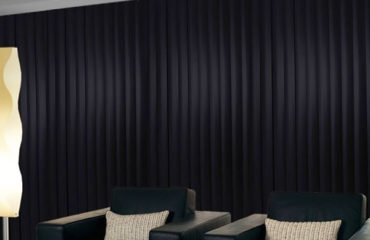When dealing with vertical blinds, there are a few important points people should know. Whether you are working with these as a buyer, seller, maintenance person or installation specialist, the following are the very basics of vertical blinds.
Many different kinds of window blinds are available via different manufacturers. The variety reflects the many differences and particular functions of the blinds, so when looking for a product that will fulfill a specific purpose, it is important to keep these distinctions in mind. The usual selection of vertical shades includes polyvinyl chloride (or PVC, a type of plastic), as well as wood, fabric and metallic or mirror finish vanes.
Vanes, also sometimes referred to as slats depending on whom you’re speaking to, are the part of the blind that gives the actual coverage and manoeuvres the direction of light. They are the part of the unit that is interchangeable and as such they can change the shade’s functionality, durability and decorative style. When we refer to wooden, fabric, polyvinyl chloride or metallic/mirror blinds, we are specifically referring to the type of vane or slat that makes up the blind.
If affordability is your main concern, Polyvinyl Chloride – PVC Window blinds may be the best choice for you. Typically cost effective, come in a variety of colors and designs, and are strong and durable, and easy to clean. They are a good choice for commercial areas, rooms with a contemporary decor or even child’s rooms. As they are typically resistant to crayon and other scuff marks.
Any type of vane will offer a great deal of light control. Their rotational design allows for a great degree of control, allowing you to let in as little or as much light as is needed. Still, different kinds of vanes will yield different results.
Free hanging fabric vanes for example, do more to filter light than to obstruct it completely. If you want a good degree of natural lighting but still wish for maximum privacy and protection from ultraviolet rays, fabric slats are your best bet.
For insulation purposes, wooden vanes are the way to go. These come in a variety of stains, colors, thicknesses and wood types. Some woods are most costly than others, especially higher quality woods. The main difference between these and lower end models are durability and resistance to environmental factors. Both offer the same functionality, with thicker slats making for better insulators than thinner ones.
About the only drawback to wooden vanes is that climate, environment and sunlight itself can warp the wood slats over time. In higher quality wooden slats, the change is less noticeable and much more gradual. Good upkeep is essential in keeping these looking their best.
Metallic, sometimes called mirrored, vanes have sheer slick finishes and are great for commercial settings or more contemporary decor. They are also very easy to handle, clean and care for. Their finish helps reflect light and therefore regulate heat and can help keep a room’s temperature hospitable.
There are also many combination types of vanes and finishes. This means that a single slat can have the characteristics of two types of vanes. These can provide additional benefits if used in the appropriate settings. Polyvinyl backed blinds with fabric fronts can give you all the durability of the former with the decorative style of the other. These slats are usually thicker and make for better light control. Depending on the materials used, they can also insulate quite efficiently.
Mirror, metal or wood vanes can also be combined with fabric or even PVC backing. See specific manufacturers for details on their selection and whether or not they offer any customized vanes. Shopping around is the best way to figure out which products will contribute the most to your home.
Learn more about window blinds. Call us our designers at 9643272829 or contact us to find out all about vertical blinds. Find out what DkOr Designs can do for you in your home or office.

